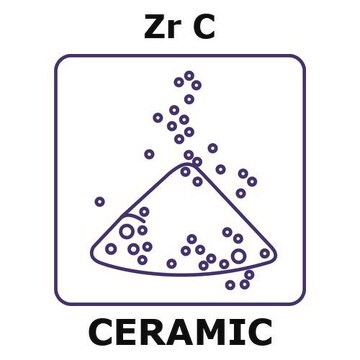636967
Titanium carbide
nanopowder, ≤200 nm particle size (SEM)
Sinónimos:
Titanium(IV) carbide
Iniciar sesiónpara Ver la Fijación de precios por contrato y de la organización
About This Item
Fórmula lineal:
TiC
Número de CAS:
Peso molecular:
59.88
Número CE:
Número MDL:
Código UNSPSC:
12352302
ID de la sustancia en PubChem:
NACRES:
NA.23
Productos recomendados
formulario
nanopowder
tamaño de partícula
≤200 nm (SEM)
bp
4820 °C (lit.)
mp
3140 °C (lit.)
densidad
4.930 g/mL at 25 °C (lit.)
densidad aparente
0.45 g/mL
cadena SMILES
[C-]#[Ti+]
InChI
1S/C.Ti/q-1;+1
Clave InChI
YXIVWSJCLXKLJL-UHFFFAOYSA-N
¿Está buscando productos similares? Visita Guía de comparación de productos
Categorías relacionadas
Aplicación
- Conductive two-dimensional titanium carbide ′clay′ with high volumetric capacitance: This study demonstrates the high volumetric capacitance of titanium carbide (Ti3C2) films, which are produced by etching aluminum from titanium aluminum carbide (M Ghidiu et al., 2014).
- Unique lead adsorption behavior of activated hydroxyl group in two-dimensional titanium carbide: The research highlights the lead adsorption capabilities of 2D titanium carbide due to activated hydroxyl groups (Q Peng et al., 2014).
- Transparent, flexible, and conductive 2D titanium carbide (MXene) films with high volumetric capacitance: This article describes the synthesis and properties of transparent and flexible 2D titanium carbide films, which exhibit high volumetric capacitance (C Zhang et al., 2017).
Código de clase de almacenamiento
11 - Combustible Solids
Clase de riesgo para el agua (WGK)
WGK 1
Equipo de protección personal
Eyeshields, Gloves, type N95 (US)
Elija entre una de las versiones más recientes:
¿Ya tiene este producto?
Encuentre la documentación para los productos que ha comprado recientemente en la Biblioteca de documentos.
Los clientes también vieron
T Henning et al.
Spectrochimica acta. Part A, Molecular and biomolecular spectroscopy, 57(4), 815-824 (2001-05-10)
We review the evidence for carbides in space both from infrared spectroscopy and direct measurements on presolar grains extracted from primitive meteorites. The paper includes a discussion of the structural properties of silicon carbide and metal carbides and their formation
Jorge L Chávez et al.
Nanotechnology, 21(5), 055703-055703 (2009-12-22)
Hybrid organic-inorganic templates and core-shell nanoparticles were used as models to study the communication between fluorescent probes placed inside nanoparticles. The hybrid templates were prepared on the basis of a mixed-surfactant system using octadecyltrimethoxysilane as a reactive amphiphile. The core-shell
Xiaoli Cui et al.
Journal of nanoscience and nanotechnology, 7(9), 3140-3145 (2007-11-21)
In this paper, nanostructured carbon-doped titanium dioxide (TiO(2-x)Cx) has been fabricated from titanium carbide (TiC) thin film using electrochemical anodization in a solution containing fluorine ion. The resulting samples were characterized via scanning electron microscopy (SEM), energy dispersive X-ray (EDX)
K J MacKenzie et al.
Solid state nuclear magnetic resonance, 4(4), 193-201 (1995-05-01)
The first 47,49Ti, 13C, 14N and 15N solid-state nuclear magnetic resonance (NMR) spectra of titanium carbide, nitride and a series of cubic carbonitrides have been obtained under both static and magic-angle spinning (MAS) conditions. The 15N samples were isotopically enriched
Minzhi Wang et al.
Bioelectrochemistry (Amsterdam, Netherlands), 86, 46-53 (2012-02-22)
We report on the direct electrochemistry of myoglobin (Mb) immobilized on a composite matrix based on chitosan (CHIT) and titanium carbide nanoparticles (TiC NPs) underlying on glassy carbon electrode (GCE). The cyclic voltammetry and electrochemical impedance spectroscopy were used to
Nuestro equipo de científicos tiene experiencia en todas las áreas de investigación: Ciencias de la vida, Ciencia de los materiales, Síntesis química, Cromatografía, Analítica y muchas otras.
Póngase en contacto con el Servicio técnico













